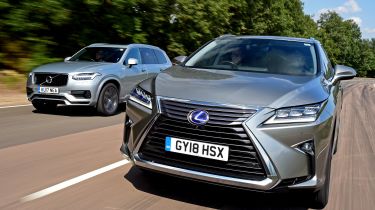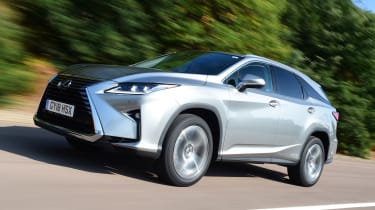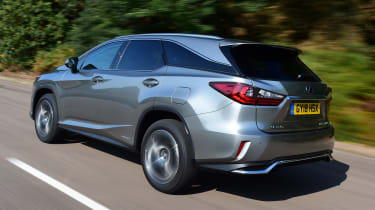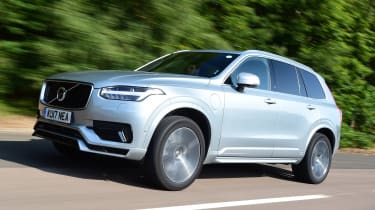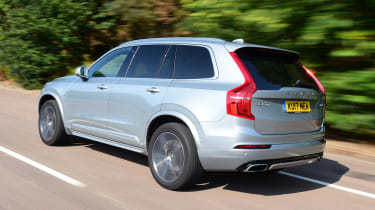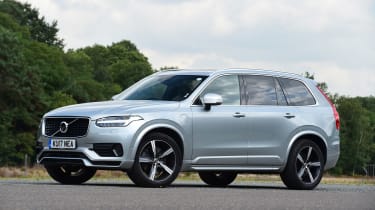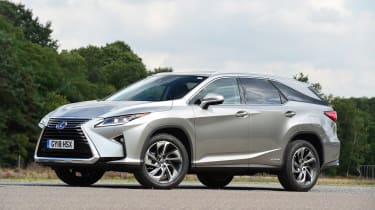Lexus RX L vs Volvo XC90
Hybrid Lexus and Volvo SUVs fit in with the latest trends. But is new seven-seat RX L a match for plug-in XC90?
Electrification is the most significant industry trend of 2018, but makers and buyers are continuing a theme from years past with a love for SUVs.
So it’s only natural that SUVs get electrified powertrains. In fact, because of the costs involved in researching and developing hybrid models, manufacturers are even more likely to use this kind of technology in a more expensive, high-end car such as a luxury SUV.
That’s where the likes of Lexus’s RX L come in. The RX was one of the first hybrid SUVs, but despite its large size it wasn’t available with seven seats. Until now. The RX L adds a third row to accommodate extra passengers.
Volvo’s XC90 T8 Twin Engine uses a petrol engine assisted by an electric motor and battery, but unlike the Lexus, it allows you to plug in to charge up the battery.
A different approach, then, but which of these two high-end hybrid SUVs is the better choice for those needing seven seats?
Lexus RX L
There’s only one powertrain available for the Lexus RX L, called 450h. Here we’re testing it in top-spec Premier trim, which costs from £61,995.
Refinement is the single word that sums up the RX L’s driving experience. Hit the starter button and there’s no noise at all, since the RX L relies on its two electric motors for movement at low speed – and there’s no noise when you’re stopped because the engine is shut off.
More reviews
Car group tests
In-depth reviews
Road tests
- New Lexus RX 500h 2023 review
- New Lexus RX 450h+ 2023 review
- New Lexus RX 350h 2022 review
- New Lexus RX 450h F Sport 2019 review
Used car tests
However, the RX L is still a large, heavy SUV so it’s not long before the 3.5-litre V6 petrol engine kicks in.
It’s a smooth engine and doesn’t sound unpleasant, but ask for any kind of acceleration and the revs are sent soaring by the continuously variable transmission. This somewhat dents the calm atmosphere created by the low-speed all-electric progress and excellent sound insulation.
In our tests, the Lexus completed the 0-60mph sprint in 7.6 seconds. That trailed its rival here, although its 30-50mph time was only a few tenths off the Volvo’s, so once you’re on the move the Lexus has plenty of performance.
You can choose from several driving modes to adjust the throttle, steering and suspension settings, but the changes over Normal mode aren’t very noticeable and the Lexus never feels particularly sporty; the Volvo is better to drive.
The RX L is a cruiser through and through, so Normal or Eco modes are the ones in which you’ll spend most of your time. The soft chassis set-up means motorway trips are effortless, with the suspension dealing well with bumps in the road. Still, over bigger bumps, the back wheels feel more unsettled because there’s lots of extra weight due to the long overhang and extra rear seats.
Testers’ notes: “The five-metre-long RX L feels extremely large indeed on UK roads. You sit very high up and visibility is merely reasonable, so you’ll welcome the standard 360-degree parking camera.”
Volvo XC90
The Volvo XC90 is available in more forms than the Lexus RX L; there are petrol and diesel cars as well as this plug-in hybrid T8 model. Here we’re testing the latter in Momentum trim (our pictures show an R-Design Pro), which costs £62,570.
Volvo is making steps towards full electrification in its range of cars, and at the moment models such as the XC90 T8 are filling that gap in its range by offering both efficiency and versatility; this is a hybrid that you can plug in at home or at work to keep the battery topped up, avoiding heavy use of the engine to keep it charged, although the car also has a mode to force-charge the battery.
The 2.0-litre petrol and electric motor serve up a combined 385bhp and 640Nm of torque, which meant the XC90 outperformed the RX L in our track tests. The Volvo sprinted from 0-60mph in 5.7 seconds, which is impressive for a near-2.3-tonne SUV. Off the line you can feel the 86bhp electric motor’s instant torque, helping boost performance while the 299bhp engine starts to build up power.
It’s similar to the Lexus in that regard, but while the RX L has a naturally aspirated engine that needs extra revs to make progress, the Volvo’s petrol engine is punchier once it comes on boost.
The gearbox is good at picking the right ratio and managing changes smoothly, but it doesn’t respond as well in manual mode because it doesn’t hold on to gears and changes down unpredictably.
Due to the vagaries of their respective transmissions, neither of these cars was able to be tested in gear (the Lexus doesn’t even have traditional gears as such), but the Volvo was faster from 30-50mph and 50-70mph in our tests. Its more powerful motor and battery set-up gives added flexibility and low-down performance.
From 30-70mph through the gears, the XC90 took 5.1 seconds; the RX L managed a time of 6.2 seconds.
The Volvo’s £2,150 Active Four-C Chassis air suspension sometimes struggles to control the body and wheels over rough roads in the same way it does on non-hybrid models. That’s because the T8 version is laden with a heavy battery pack, so the weight affects comfort and handling. Nobody is likely to buy a large SUV for handling prowess, however, and the XC90’s well-weighted controls and plentiful grip mean it’s good enough from behind the wheel.
It resists roll better than the RX L and the Lexus is just as heavy and cumbersome. Also, the Volvo is just as comfortable at high speed as its rival, but isn’t quite as compliant at low speed.
Testers’ notes: “There is lots of leather, many metal details and plenty of tech in the XC90’s cabin. It’s comfortable to sit in, and build quality is solid. The infotainment system is much better than its rival’s, too.”
Verdict
First place: Volvo XC90
The XC90 T8 is more efficient, cheaper to run and more spacious than its rival – all key factors in a hybrid seven-seat SUV. That it’s also better to drive and delivers more performance means it’s a clear winner. There’s a similar level of kit and quality on offer, but in almost every area the XC90 beats the RX L. It’s a more convincing hybrid machine.
Second place: Lexus RX L
It’s smooth, refined and beautifully built, but crucially this seven-seater Lexus RX L doesn’t have enough room in the back to be worthy of recommendation. The third row of seats, the only reason to buy the car over a standard RX, is cramped. Its hybrid drivetrain also isn’t as effective as the Volvo’s, and the car is hampered by a terrible infotainment system.
Other options for similar money...
New: Audi Q7 e-tron
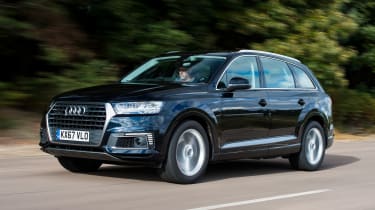
Price: £65,750Engine: diesel/electric, 369bhp
Audi offers a different take on electrification with its diesel-electric Q7 e-tron. Its 3.0-litre V6/electric motor drivetrain is torquey and relatively efficient, but this luxury SUV is only a five-seater.
Used: Tesla Model X
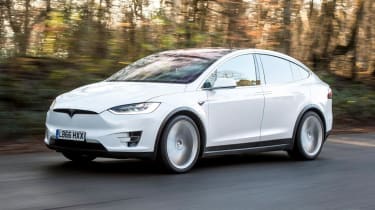
Price: £72,000Engine: electric motor, 328bhp
If you want a used all-electric SUV, a Tesla Model X is your only choice. It’s spacious and the rearmost seats are usable, but even with a claimed 350-mile range, this EV may require you to make lifestyle tweaks.
Figures
| Volvo XC90 T8 Twin Engine Momentum | Lexus RX 450h L Premier | |
| On the road price/total as tested | £62,570/£62,570 | £61,995/£63,635 |
| Residual value (after 3yrs/36,000) | £32,299/51.6% | £31,047/50.1% |
| Depreciation | £30,271 | £30,948 |
| Annual tax liability std/higher rate | £2,000/£4,000 | £3,458/£6,915 |
| Annual fuel cost (12k/20k miles) | £1,866/£3,111 | £1,981/£3,301 |
| Ins. group/quote/road tax | 42/£632/£440 | 43/£614/£440 |
| Cost of 1st/2nd/3rd service | £330/£560/£330 | £295/£495/£295 |
| Length/wheelbase | 4,950/2,984mm | 5,000/2,790mm |
| Height/width | 1,776/2,008mm | 1,700/1,895mm |
| Engine | 4cyl in-line/1,969cc | V6/3,456cc/2 x e-motor |
| Peak power/revs | 385/5,700 bhp/rpm | 308/6,000 bhp/rpm |
| Battery/charge time | 10.4kWh/3 hours | 1.9kWh/N/A |
| Transmission | 8-spd auto/4WD | CVT automatic/4WD |
| Fuel tank capacity/spare wheel | 70 litres/repair kit | 65 litres/space saver |
| Boot capacity (7/5/2-seat modes) | 262/640/1,816 litres | N/A/495/966 litres |
| Kerbweight/payload/towing weight | 2,274/736/2,400kg | 2,205/635kg/N/A |
| Turning circle/coefficient of drag | 12.2 metres/0.29Cd | 13.8 metres/0.33Cd |
| Basic warranty (miles)/recovery | 3yrs (60,000)/3yrs | 3yrs (60,000)/3yrs |
| Driver Power manufacturer/dealer pos. | 13th/9th | 1st/1st |
| NCAP: Adult/child/ped./assist/stars | 97/87/72/100/5 (2015) | 91/82/79/77/5 (2015) |
| 0-60/30-70mph | 5.7/5.1 secs | 7.6/6.2 secs |
| 30-50mph (kickdown) | 2.2 secs | 2.5 secs |
| 50-70mph in (kickdown) | 2.9 secs | 3.7 secs |
| Top speed/rpm at 70mph | 140mph/1,800rpm | 112mph/1,800rpm |
| Braking 70-0/60-0/30-0mph | 50.8/38.9/10.6m | 49.8/42.6/10.9m |
| Noise outside/idle/30/70mph | N/A/42/61/70dB | N/A/41/61/70dB |
| Auto Express econ (mpg/mpl)/range | 38.2/8.4/420 miles | 36.0/7.9/515 miles |
| Govt urban/extra-urban/combined | N/A/N/A/108.6mpg | 45.6/47.1/47.1mpg |
| Govt urban/extra-urban/combined | N/A/N/A/23.9mpl | 10.0/10.4/10.4mpl |
| Actual/claimed CO2/tax bracket | 171/59g/km/16% | 181/138g/km/28% |
| Airbags/Isofix/park sensors/camera | Seven/yes/yes/yes | 10/yes/yes/yes |
| Auto box/lane keep/blind spot/AEB | Yes/yes/£500/yes | Yes/yes/yes/yes |
| Clim ctrl/cruise/leather/heated seats | Yes/yes/yes/yes | Yes/yes/yes/yes |
| Met/LED lights/keyless/power tailgate | £700/yes/yes/yes | £645/yes/yes/yes |
| Nav/digi dash/DAB/connected apps | Yes/yes/yes/yes | Yes/no/yes/no |
| Wireless charge/CarPlay/Android Auto | No/£300*/£300* | Yes/no/no |
